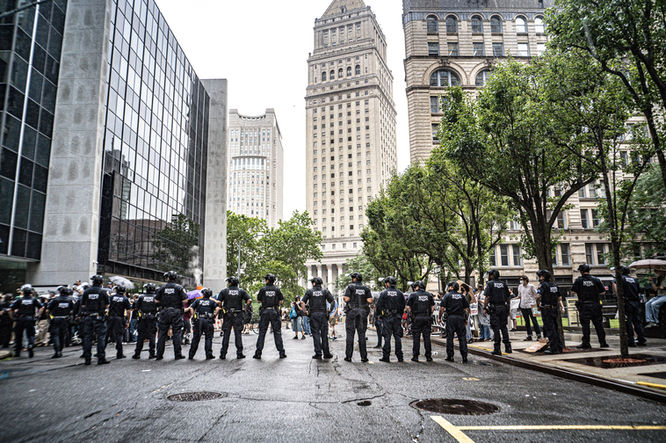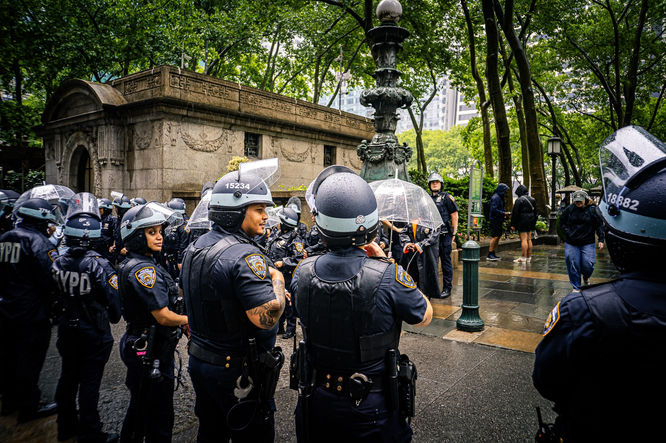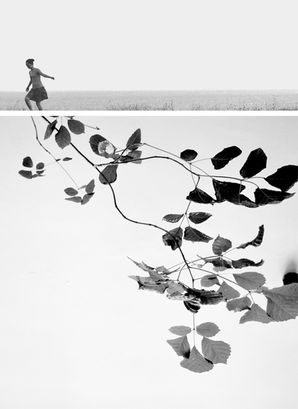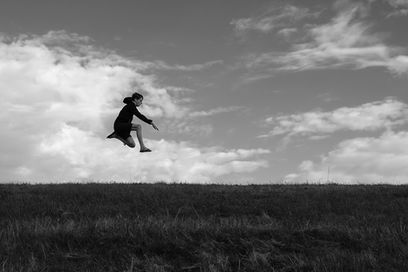
WHAT DO WE WANT?
More than documentation, David Gray reveals the human pulse of resistance and asks us to see beyond the surface of unrest.
August 10, 2025
INTERVIEW
PHOTOGRAPHY David Gray
INTERVIEW Karen Ghostlaw Pomarico
David Gray is not the kind of photographer who simply shows up to take the shot. His work emerges from time, presence, and attention, the three things that can’t be faked or rushed. A Scots-born photographer and writer now based in New York City, David’s creative path has taken him across continents and subcultures, from the remote mountains of Colorado to the chaotic pulse of urban protests, from the car-laden backroads of Florida to quiet corners of public institutions. What ties his work together is not subject matter alone, but an enduring commitment to observe carefully and connect deeply, whether with a place, a political moment, or the people who inhabit both.
David is co-creator and one half of the photography team for Driver’s Journal, a print publication documenting America's love of automotive culture. His photography has appeared in publications such as The Sun Magazine, and he’s currently developing a series of large-format, 200-page print volumes that reflect his long-form, immersive approach. His most recent monograph, a portrait of New York City, was released by Grand Editions in late 2024 and quickly sold out, a testament to the resonance and reach of his photography.
David’s recent residency as Photographer-in-Residence at Brooklyn’s Central Library took him deep into the life of an institution that serves both as cultural anchor and community lifeline. That project, soon to be released as a major photo essay and exhibition, pushed him to document not just people but systems that support, fail, or quietly sustain everyday life.
His ongoing series, What Do We Want? reflects his interest in how public life unfolds during times of protest. Photographed over the course of a year in New York City, the project looks beyond the expected images of marches and signs. Instead, it focuses on the everyday moments that shape these events, listening to people in conversation, the presence of police, the reactions of bystanders. Through this quieter approach, David explores how social and political movements are experienced on a human scale.
As a Green Card holder, David is also aware of the personal risks that come with documenting civil unrest. And yet, his journalist’s training and ethical grounding propel him to bear witness anyway. He follows the story, even when he’s unsure where it ends.
In the conversation that follows, David reflects on the emotional and ethical dimensions of image-making, the balance between truth and care, that guide his practice. His commitment to walking five to ten miles a day through New York City, builds his vocabulary of visual narratives that live in books, exhibitions, and memory.

“As a journalist and photographer, you’re always ‘other’ in a sense: never belonging, always witnessing. And as a Green Card holder, I’m aware of my status here as a guest. I love NYC, and by extension, the USA: what it stands for and its potential and principles are unique, and special. I would hope that journalists who are reporting objectively and fairly will always be welcome, but I am aware that one misunderstanding could imperil my path to citizenship. I can’t not document my adoptive city and country, though, because what seems mundane to us now, or awful, will to future generations be as fascinating and alien as those old subway pics we marvel at, with the graffiti and Guardian Angels.”
IN CONVERSATION WITH
DAVID GRAY
TPL: The title What Do We Want? is both evocative and open-ended, yet grounded and rooted in protest, still resonating far beyond slogans. What does that question mean to you personally, and how does it shape the way you framed the images in the series? How do you translate not just the action of protest, but the emotional undercurrent of grief, rage, hope, resilience, then turning a single image, into a lasting frame?
DAVID: I remember student protests in Scotland, where someone would always shout, “What do we want?” and someone else would yell back the answer(s). “And when do we want it?” the original shouter would reply. “Now!” the crowd would shout. And that would repeat endlessly, growing in volume and passion. There’s something primal in most of us, that wants to be part of a crowd, with a clear purpose and magnified power. And I was and am fascinated by the way ordinary people become extraordinary when they have a crowd at their back and a megaphone in their hand. Every emotion is heightened, and every detail exaggerated. These protests, though, had simple political goals. What I see here are protests that are umbrella movements for anger. And in the case of the Drag March and the Queer Liberation March, a defiant wish to be seen and counted. Whatever the motive, protests take courage, and we should all be proud of that, even if we don’t feel the same passion for a particular cause.
TPL: As this series begins to take on new forms, as an exhibition, as an essay, what kind of impact or dialogue do you hope What Do We Want? sparks? What do you want viewers to carry with them? What is their takeaway, what is yours?
DAVID: Documenting protest in a city where people co-exist despite vast differences, is to witness the social compact fray at the edges. It offers a glimpse of what lies under the surface. For the most part, protests in America are a way for people to blow off steam without burning it all to the ground. It’s democracy’s wonderful pressure valve. That’s what I’d love viewers to see, though what people take from my pictures is entirely up to them. We all see things differently: the trick is to appreciate that, and to know the power of a photograph. All too often protests are reduced to a sensational image of violence. Don’t get me wrong: flashpoint moments are news, and have to be recorded, but they can play into the hands of those who would equate protest with violent revolt. My own takeway? Ordinary people in extraordinary times need a last recourse, and that is public protest.
TPL: Has your experience with What Do We Want? opened new directions you want to explore, whether in protest photography, or in entirely different spaces, cultures, or themes that you feel drawn to next? As you look ahead, are there questions you haven’t yet resolved through your work, about people, power, or place? Does that continue to drive you forward creatively?
DAVID: I will keep taking protest pictures, as I sense this is only the beginning, as we respond to political and social change. I look forward to seeing what protests and marches might evolve into, if anything: I sense that it takes a lot to make Americans go out on the streets and protest, and it’s hard to know if there’s the appetite for much more of that.
I always have other projects simmering. I’d love to take my recent Brooklyn Public Library residency and apply that approach to a great museum or gallery. And my passion project – to record and understand why people act as they do, at the 9/11 Memorial Pools – may or may not come to a conclusion. I’ll also keep taking pics on, around and of The High Line, and the people who crowd onto it and often look like they don’t know why they came. And then there’s my ongoing project on the subject of how people behave around art…I could go on…basically there’s no limit to the things I want to shoot.
In tandem, I’m in talks about a bi-annual photo pictorial of my NYC shots, with themed sections, and a long read by an author whose love affair with the city will serve as a counterpoint to my images. That may need a sponsor who adores NYC as much as we do, so who knows.
TPL: Has documenting these protests and spending so much time immersed in the city’s charged political and cultural life, changed your understanding of America? What about your place within it? Looking back on What Do We Want? - how has this experience shaped the way you see the country, the city, and yourself? As this chapter of your work evolves, what will propel you forward from the streets, the people, and the moments that made you raise your camera?
DAVID: I’ve barely scratched the surface of NYC, let alone America. But seeing why people protest, and how (and how often they don’t protest at all) has given me some minor insight into what makes society here work. I think that within the USA, individual states differ more than European nations do (language aside) and that people are struggling to find a meaningful national identity. There’s nothing like pointing a camera at someone to let you see their true character. And – touch wood – I’ve found the overwhelming majority of people here to be good hearted and kind, even if they don’t always know how to express that kindness to fellow Americans (and would-be Americans) who they don’t understand. The experience has also reminded me of the need for balance: there are people who seek to paint the great cities as anarchic hellholes, whereas I see in NYC eight-million-something people all mostly getting along and seeking to sleep safe in their beds at night. So, I’ll also keep shooting dogs sleeping in cafes and people doing wheelies on bikes: the everyday stuff that society runs on.
TPL: Can you share the backstory behind one photograph that deeply moved you? Perhaps an image where something in the atmosphere, gesture, or energy instantly connected with you and made you press the shutter without hesitation?
DAVID: Of the protest set it’s perhaps the quietest one. It’s a close up (and a little soft) night shot of a woman turning to look past me, and her eyes are glistening. The full story of what was happening at that exact moment isn’t clear in the image (so in that sense it was a flawed shot, though aren’t they all?): it was the end of the Drag March, and a crowd had gathered outside the Stonewall Inn to sing Somewhere Over the Rainbow. It sounds a little corny, but there and then it was one of the most moving things I’ve ever witnessed. I think she was overcome with emotion as the song ended, and looking for someone, but I might be reading too much into a moment that was gone in a flash.
That’s the power and danger of a still image: we can interpret it any way we please.

TPL: When you’re photographing someone in a moment of intensity, vulnerability, or confrontation, especially in communities outside your own, how do you balance the responsibility to tell the truth with the need to protect dignity? What guides you in making those calls with both care and clarity?
DAVID: I always have in my head the question, “What would that person’s mother think of the photo you’re about to take?” Of course I’ve no way of knowing the answer, and if I only took photos, I was sure someone’s mum would love, I’d hardly ever press the shutter button. But as a rhetorical question it helps remind me of my purpose and responsibility. I’m not a fan of ‘poverty porn’, where the picture only serves to show someone at their lowest point, with no greater purpose than titillation. Equally, I’m not telling anyone else what to take or not to take: documenting the human condition is vital. But every photo posted affects how we see ourselves and our society, and we have a duty to be honest about our motivation for portraying things the way we do. And that’s never more acute than when photographing communities outside of our own. I wouldn’t assume everyone loves the pictures I’ve taken of them, but I hope they would agree I treated them with respect.
TPL: Walking five to ten miles a day through New York has become part of your creative rhythm. How has that daily practice shaped the way you see and photograph protest, or the city more broadly? Has it helped you tune into the unspoken cues or emotional currents of public gatherings?
DAVID: It means I stumble across things that I would otherwise have missed. I was recently on the way to the Memorial Pools at the 9/11 Museum as part of yet another of my obsessions: documenting how people behave at a sacred site. En route, I walked into an anti-ICE protest downtown, that was because of its spontaneity and anger, one of the most memorable. A few days later, on a hot summer night, a similar protest stalled at a particular junction, and the mood abruptly changed for the worse. There were more police than protesters, and they became my focus: their formations and intent, a sense of watchfulness and implicit warning. Living in the city means always having a sense of the mood, and the knowledge that things can change quickly. That said, of all the cities I’ve lived in, I rate NYC as the most gregarious and open. As a Brit, you have to lose the urge to waffle politely when asking a stranger for help: “Excuse me, sorry to bother you but…” will ensure you get nowhere. If you get to the point, though, people will go out of their way to assist. Or at the least, tell you what they think at full volume.
TPL: Your images often focus not on spectacle, but on what’s unfolding quietly at the edges: bystanders, police, stillness in the quiet tension that surrounds moments of public unrest. What are you hoping to reveal by including these often-overlooked perspectives? How do these peripheral figures add to the emotional and political complexity of the story you're telling?
DAVID: When you look at protesters and police in NYC, it’s easy to see utterly opposing sides. But if you could see connections as an overlay, we’d see all kinds of associations, and commonalities. The police shape the protests and contain them, and give them a sense of purpose as well, since they are often the visible arm of the very things the protesters are on the streets to protest against in the first place. When you have tens of thousands of protesters, and thousands of police, plus marshalls, legions of bemused tourists and intolerant motorists all crammed together, you see people at their most alive. The center of a protest is mostly predictable and vivid. The edges are where the dynamic is most flexible and most important, because it’s where protesters and police and passersby all meet, rub up against each other. A thousand little dramas play out on the periphery. I love to be able to move in and out, to see the faces of police from inside the protest, and to frame the protesters from the point of view of the police and bystanders.
TPL: Before your camera even leaves your side, what speaks to you first in a new place, whether you're halfway around the world or just across the city? Is it the rhythm of people, the quality of light, a flicker of tension? What tells you there’s something worth listening to with your lens — across cultures, across borders?
DAVID: I just start walking. I have a very poor sense of direction, and it takes a lot of miles before I have any idea where I am. My niece visited NYC recently, and wanted to go to the Met Museum, which is one of my favorite places. It went well until she started to ask me to show her specific items, and it became clear I had no idea how to find any of them. “How can you be lost when you come here all the time?” she demanded. “Not knowing exactly where you are isn’t the same as being lost,” I explained. Amazing things happen when you don’t have rigid expectations.
TPL: You’ve photographed everything from rural car culture to public institutions to protest marches. What connects these projects for you? Is there a thread or question that runs through all of your work, regardless of subject?
DAVID: People. The way people react to their environment and each other is endlessly fascinating. I’m intrigued by everyday interactions and fleeting emotions. I could look at faces all day long, but often shoot people from behind, because that places the viewer in the driving seat, almost like a first-person video game, and rather than being distracted by trying to read too much into an expression, we see what the subject sees, and where they’re going. We then make all kinds of mental connections and guesses based on conscious and unconscious cues and biases. Landscapes – particularly urban ones – without people are also fascinating. We do not, as a species, tread lightly on the environment.
TPL: Many of your projects, especially your long-format print volumes, require patience, endurance, and deep focus. In a fast-paced media world, why have you chosen to work in this slower, more sustained way?
DG: There’s a nostalgia for a time when images and words were tangible things. I do a lot of digital work, but I’ve never been busier on print projects than right now. The printed page, and the ability to juxtapose images and build a narrative through the order and presentation, is unmatched. I was fortunate recently, to experience something that people like us seldom do: witnessing others react to my work in a public setting. I had promised to deliver an issue of a print mag I’d shot for, to a legendary automotive designer (it’s always a pleasure photographing people who are passionate about whatever they do). I did so quietly in a hotel bar, and to my horror, he made a fuss, gathering a collection of his world’s great and good around, so they could go through the magazine page by page. That is pretty much my worst nightmare, as I hate being the center of attention. So, being quizzed on every shot, and having people (unasked) articulate what they took from it and ask me why I had shot things as I had, was excruciating. It must have taken 20 minutes, that felt like hours, and I was a puddle of sweat by the end. But what an honor, to see your work through others’ eyes.

David Gray’s photography moves beyond simply capturing moments. It explores the deeper stories and emotions within them. Whether documenting protests in New York City, daily life in a Brooklyn library, or landscapes and communities around the world, his images reveal layers of human experience often overlooked in the rush of headlines.
What Do We Want? is more than a record of protests; it’s a reflection on the complexities of social change, the quiet interactions, the emotional rhythms, and the many perspectives that make up a city alive with activism. This project stands alongside a broader body of work that connects cultures, places, and people across continents, all approached with an attentive and respectful eye.
David’s work doesn’t just observe; it engages. It listens. As both a journalist and photographer, his approach invites viewers to look deeper not just at what they see, but at the feelings and contexts that give each moment meaning.
While What Do We Want? reflects a city in motion and a photographer responding to the moment, David Gray’s wider body of work reveals a practice rooted in curiosity, patience, and respect. Each image encourages us to ask not only what do we want — but what do we see, and what do we remember?
Explore more of David Gray’s diverse and evolving work by visiting his portfolio.














































